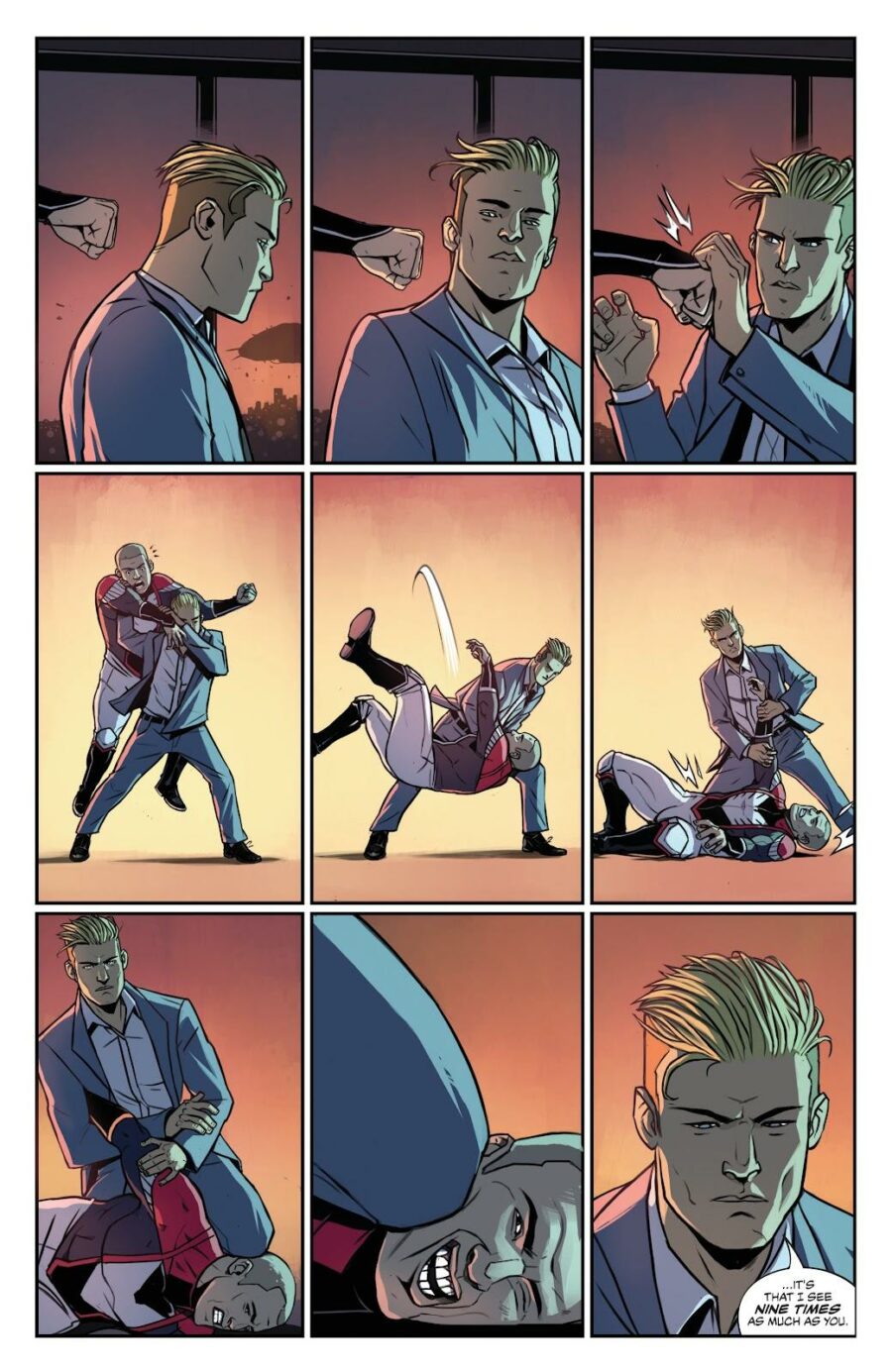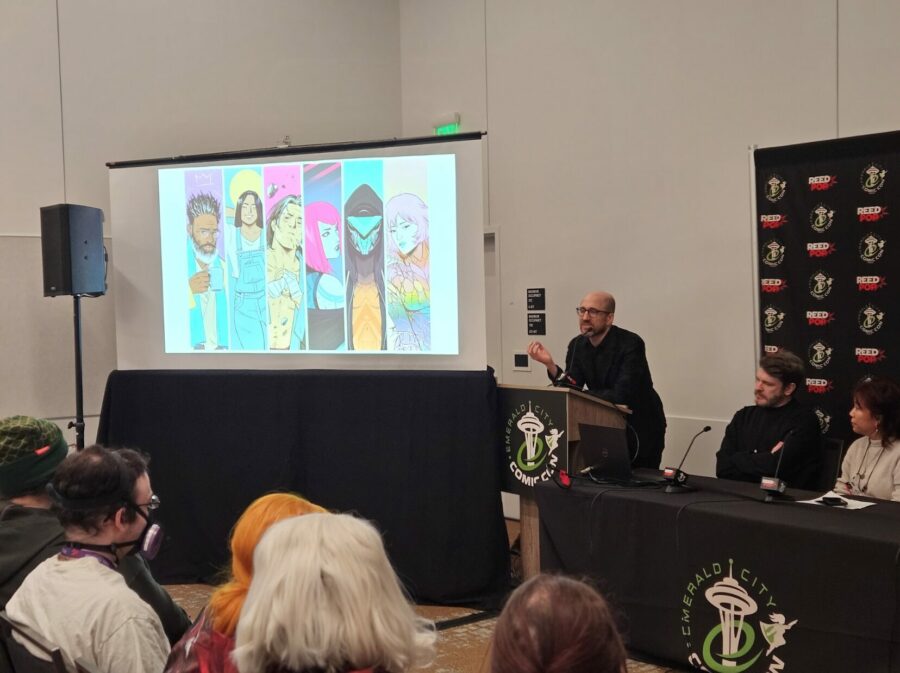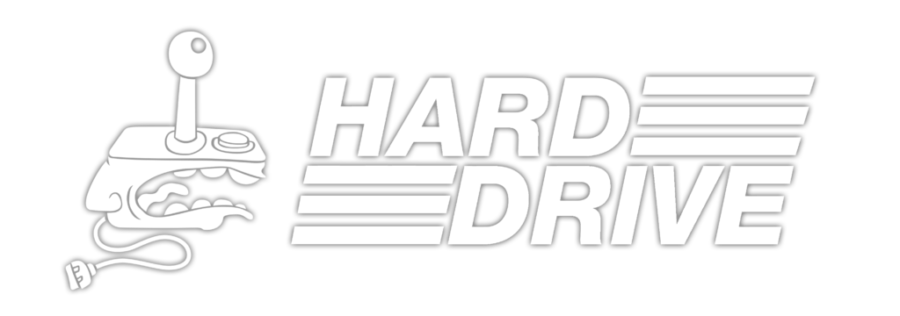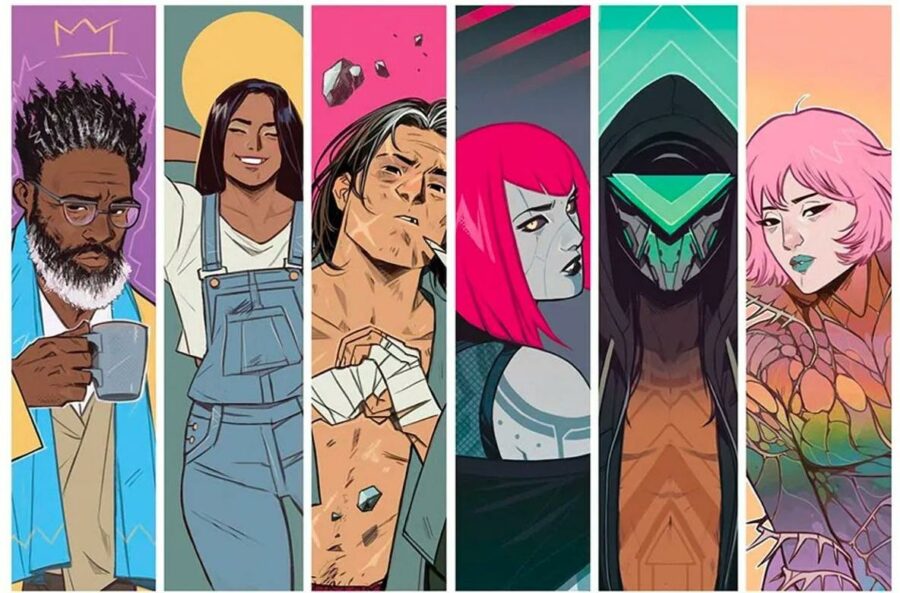You may know Kieron Gillen’s name from his work at Marvel Comics, where he’s currently wrapping up the X-Men’s “Krakoa Era” as the writer of Rise of the Powers of X, or from creator-owned books like Phonogram, Die, Once & Future, or particularly The Wicked + The Divine with Jamie McKelvie.
Gillen appeared at this year’s Emerald City Comic Con in Seattle. During a spotlight panel on his work, he announced his next project, a creator-owned book called The Power Fantasy. It features art and colors by Caspar Wijngaard (Home Sick Pilots, All Against All), who previously collaborated with Gillen on 2019’s Peter Cannon: Thunderbolt, with Clayton Cowles as letterer.
In The Power Fantasy (TPF), exactly 6 people on Earth both have and are superpowers. Any one of these people are essentially a rogue nuclear state, and if any two of them ever tried to fight one another directly, it’d probably end life on Earth.
I spoke with Gillen at ECCC on the day after the announcement, about his plans for TPF, how it compares to his previous works, and inexplicably, the Mongol invasion of Europe.
Minus World: You mentioned at your panel that The Power Fantasy came from ideas you’d had while you were working at Marvel, but that Marvel wouldn’t have let you explore them–
Gillen: Oh, no no no. I wouldn’t pitch them at Marvel. It’s very important to stress that.
Same with Wicked + Divine. You couldn’t do Wicked + Divine at Marvel because it involves creating everything from scratch, and these are kids doing cocaine and whatever. I would never pitch this at Marvel. It’s not the place for it.
I’m sorry, I jumped on your question.
MW: I was curious if you were experimenting with the comics form with TPF, the same way you were with Peter Cannon: Thunderbolt.
I had a new idea for a book I was going to pitch to Caspar [Wijngaard], and it was much more formalist. TPF is less formalist than Peter Cannon. That was a question of the [9 panels per comic page] grid. In the end, TPF doesn’t reject the grid, but says, “Why don’t we try this instead?”

The formalism in TPF is softer. This is much more impressionistic. I’m giving Caspar a lot more space, because Caspar self-colors, so he can use color and detail.
There’s a level of irony in that, of all the comics I’ve ever done, TPF is most influenced by Watchmen. Obviously, Peter Cannon was about Watchmen.
With this one, I’m doing an alternate history across X amount of time, in a novel structure, the structure of a novel, and it’s about powered people. It’s not a superhero book in that way, but it’s certainly informed by them. I described this at the panel as “What if Watchmen had 6 Dr. Manhattans?”
MW: You’ve written a superhero book where they must never, ever fight.
The older I get, the more that’s interesting to me. Superheroes are fight comics. There’s certainly a lot of violence in TPF, but there’s not a lot of fighting. Violence is the enforcement of political will.
The subtext of the book is, “What happens when an individual has too much power?” If it’s true of these 6 characters, it’s also true of billionaires. It’d be clearly better if these people didn’t exist; however, they do exist. If you find yourself as one of them, what do you do? Especially when you’ve got these other assholes who’re doing this other stuff.
The core idea came from me, in the last 10 years of superhero comics, thinking the power creep has gotten out of control. It’s priapic, almost. I looked at them and thought, “These people just shouldn’t fight.” If we wrote Storm or Thor or Hulk seriously, they would destroy the planet any time they fought.
MW: Every time you write Storm, you just have to pretend she can’t pull all the air out of your lungs.
Yeah, all the way. There is no reason why the Flash should ever lose a fight.
This isn’t a bad thing. You write the poetry of it. But this is what I mean, when you take the idea and think, “A nuclear weapon isn’t good for anything. Using a nuclear weapon ends the story.”
Then the word “superpower.” Obviously, the pun struck me, and it developed from that. “Okay, everyone’s got one superpower, and it’s really, ‘Push this button and you destroy the world.’” What can you do with that? Ideally, you do nothing with that. [laughter]
So many of my books are about people with power trying to work out how to get on, the small-p politics. I say “6 Dr. Manhattans,” but these are much more human people. They have unusual perspectives, but they aren’t Dr. Manhattan’s type of broken.
MW: How many straight lines could you draw between this and, say, [Gillen’s World War II comic from Avatar Press] Uber?
That’s the other influence. Die, WicDiv, and Uber. It’s almost like Uber done with Die’s aesthetic.
MW: Now that you mention it, this is almost a trilogy.
This feels informed by all the stuff I’ve done. “This is what I’ve done before, and this is what I think I can do better now.”
Uber is about World War II, and WicDiv is about the cultural history aspect. [TPF] is kind of a cultural history, but influenced by the Cold War. In some ways you could see it as a sequel to Uber. It’s set from 1945 to 1999.
MW: That did seem like a specifically chosen stretch of time. You mentioned power creep in comic book history, and 1999 is when [Warren Ellis and Bryan Hitch’s] The Authority came out.
I hadn’t quite put that together, actually, but you’re right. I chose the ‘90s for various reasons. It’s probably too early to talk about specifics, but there was something about the millennium. We’re now a chunk of time past that. Maybe nostalgia’s the right word. It’s time to talk about the 20th century again, especially for somebody my age.
I’m writing about music that I’ve never written about before, and about my parents. What were my parents doing in the ‘60s? What were their parents doing?
A book that’s set across a large chunk of time interests me, and seeing these people at different stages. Of course, Watchmen did that. It feels novelistic, the collage of characters across time. This is the big Watchmen influence, that Watchmen is a novel that took superhero characters and ran with them. That’s what I want to do. We’re going to tell a story about these people, and the powered element to them is a way to emphasize character.
MW: As I understand it, from what little you’ve said, these people’s existence is public knowledge.
At one point it becomes public.
MW: And they’re the same 6 people throughout?
They’re born at different times. By 1999, the oldest is 60 and the youngest is 28, I think. We allude to the whole timeline in the first issue. “That thing in ‘82.”
It’s a lot like Earth, but then you’ll wonder “Why’s that character in weird rave gear?” and “Who are these Goth-looking mod people?” It’s ‘90s pop culture, but slightly different, so what happened there? Then we explain.
Let’s talk about Watchmen again. The electric cars in Watchmen are a good example. Why are those there? Because Dr. Manhattan made cheap lithium.
MW: I wouldn’t feel too self-conscious about Watchmen. If we were talking about your new film noir movie, we’d bring up Casablanca.
I’m aware that the irony, after Peter Cannon, is that we [Gillen and Wijngaard] should be past Watchmen. What I’m actually doing is about how people didn’t use the interesting stuff from Watchmen. Watchmen was a formalist challenge to be better. This is me picking up stuff I liked and loved and running with it.
[TPF]’s a story about powered people done with serious intent. That’s the real similarity to Watchmen. People keep saying, “It looks very WicDiv-y,” because WicDiv is about people with power trying to figure out what to do, and dealing with a death wish.
So much [of TPF] is Caspar, because Caspar is so much into detail. There’s that image we’ve showed of one of the characters, who’s got a floating spliff. It’s little things like that. It’s why people love comics and fall in love with characters and worlds. The big ideas are one thing, but it’s always, “What about that bit?” The details are so important.

MW: This is a coincidence, but I just rewatched Strange Days—
Oh, yeah, I was thinking about that, to be honest.
MW: There’s that line from Tom Sizemore’s character, about how “we’ve used it all up.” The idea of a Cold War thriller based around superpowers, with a stated endpoint around 1999, really happens to resonate with that.
Strange Days was fascinating, in terms of doing a story about the millennium before the millennium. It was fantasizing about the near future. Where were you at the millennium?
MW: In a small house in Michigan, in case the Y2K bug blew everything up.
That’s funny. Not funny, but I know what you mean. I was wandering the streets drunkenly in Bath, because the streets were so quiet. On the millennium, everyone went to inside parties. In Phonogram, there’s a scene with a girl on a bridge [in issue #2]. I was on that bridge at the millennium.
I’m so into the sense of place. I really want the ‘60s to feel like the ‘60s. TPF opens with two of the characters eating pizza in New York in 1967. That to me is the heart of it, and also, weirdly, the heart of the Marvel Universe. The definition of Marvel Comics is, “If you can’t imagine these characters eating pizza, they probably aren’t core Marvel characters.”
MW: “The world outside your window.”
Yeah. Eating pizza.
MW: I didn’t put it together until you mentioned rave gear just now, that that character you showed off in your lineup is doing a Deadmaus thing.
That’s funny. [spoiler omitted] is actually a complicated character—I shouldn’t have said his name. I might change that.
He’s the 1970s punk character, and the mask is about something else, but it’s definitely that EDM vibe. EDM has a very different meaning in this world.
MW: There was that subplot in Watchmen about how the presence of superheroes meant pop culture had changed, so comics about pirates were really popular in-universe.
I don’t want to get into specifics, but all these characters are evoking different periods in pop culture, and also influence it a bit. That character I just mentioned is very punk rock. Imagine if Johnny Rotten had the power of Dr. Manhattan.
MW: I immediately pictured the UK blowing up.
That whole thing is interesting. Speaking very broadly, for reasons of timelines, the ‘70s and ‘80s are more left [in TPF] than they were in the real world, and the ‘90s are more right. There are events that shape that.
MW: There’s so much in the 20th century where nations would be creeping around, thinking “I hope one of the superpowers doesn’t notice what we’re doing.”
Then you have “great man” theory, which revolves around what happens when one person has so much power that they can really change everything. I used an example in Eternals, where [during the 13th-century Mongol invasion of Europe] one of the Khans died. The conquering of Europe stopped, because everyone had to come back east to sort out who’d be next. If not for that, they’d have hit the coasts and gone all the way through France. The Khans’ army was much better than anything else in Europe at the time.
A big part of [TPF] is, “What if the next superpower arrives and it’s Jeffrey Dahmer?” If you randomly pick someone and give them ultimate power, you’re rolling the dice every time. Different characters have different takes on what that means. Some are more utilitarian, some are more humanistic. Others are assholes, in different ways. We make this all about the people, and that’s what interests me about the idea.
Maybe talking about the big ideas may make it appear cold, but what I’m hoping to get across through interviews is that these are interesting questions. Somebody asked at the panel, “How do they know they’re superpowers, if they can’t use their powers?” Obviously that’s a big part of the book. Until two of them go to war, you don’t really know how powerful they are. They may look good on paper, but they fold.
Britain in World War II spent a lot of money before the war started on aerial power, because they believed that aerial power worked better than it did. They were wrong. Germany spent money on tanks, because they thought blitzkrieg would work, but it maybe didn’t. Imagine a history where the bets were the other way around. You don’t really know until the shit hits the fan.
MW: You talked on Bluesky about how you envisioned this as an ongoing series. In a perfect world, how long do you envision TPF will run?
I’d never say that. I never say how long I mean by ongoing, but almost all my work are novels. Die is 20 issues, and was basically 25 to 30 issues worth of content, since the page count was longer. Once & Future was 30 issues. WicDiv was 50. Uber will be 50 if we ever finish it. I would say it, in an ideal world, is somewhere in that area. 20 to 50 issues.
I always plan for short endings as well. There’s a way of ending it shortly, which is also cool.
MW: You’ve already baked in a really easy way to end the whole thing.
Yeah. “Whoops!” [explosion noise]



